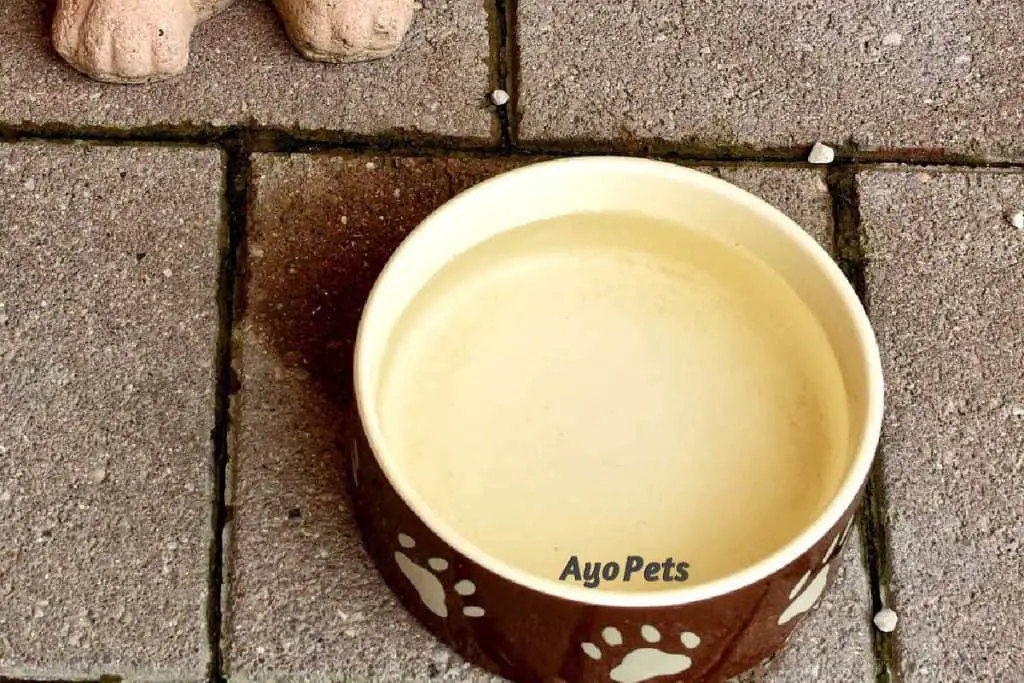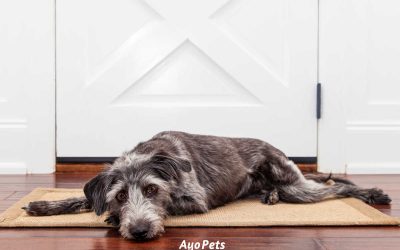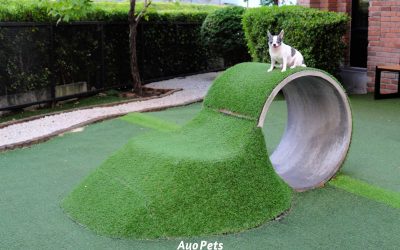There’s nothing like a refreshing bowl of water for your dog to drink after a good meal or a fun game of fetch. A dog’s water bowl is one of those things you’ll look after daily as a dog owner, but what if you’ve seen icky furry mold growing inside it?
There must be a simple, effective way to keep mold out of the water bowl. Well, I did a little digging to find out and there actually is…
How to clean a dog water bowl to prevent mold

The best way to keep mold out of a dog’s water bowl is to follow a 3-step cleaning system:
1. Wash the bowl in hot, soapy water
Wash your dog’s water bowl with hot, soapy water every day. This removes dirt on the surface of the bowl, such as natural oils from your fingers and saliva or food particles from your dog’s mouth.
You can wash the bowl in a bucket, the kitchen sink, or in the dishwasher if the bowl is dishwasher safe.
I recommend keeping a separate sponge for washing the dog’s water bowl, and not using your household kitchen sponge for the job. This will stop you from spreading any germs and bacteria from the dog’s water bowl to your family’s dishes.
Be sure to use non-toxic soap that’s pet friendly, such as this affordable organic soap from Amazon. Your dog drinks out of the bowl, so try not to use any harsh or poisonous chemicals.
Give the bowl a few minutes to soak so the soap can do its job. Then give the bowl a good scrub down with a sponge – don’t use a scourer or anything that might scratch the surface as mold loves growing in tiny scratches (more about this later).
Rinse the bowl with clean water until there is no soap residue left on the surface.
Now that you’ve removed the surface dirt, it’s time to tackle any mold that has settled on the bowl, even if you can’t see it growing yet.
2. Disinfect the bowl
Hot, soapy water should remove any mold growing on the surface of the bowl, but it doesn’t always kill or stop mold spores. Mold spores are the ‘seeds’ that grow mold.
Mold spores can only grow mold if the spores are alive and find the right environment to start growing in. Killing the spores or making sure they don’t like it in the dog’s water bowl will stop new mold from growing in the bowl.
The best way to kill or stop mold spores from growing is to disinfect the water bowl once a week.
Disinfecting a dog’s water bowl is actually easy and there are a few ways to do this, such as using commercial products or extreme temperatures. Just be sure to use a method that the bowl can withstand, for example a stainless steel dog bowl can’t go in the microwave but it can go in the freezer.
Did you know? Most molds are destroyed or cannot grow at hot temperatures of 140-160°F (60-71°C) and cold temperatures below 40°F (4°C). Mold likes growing at temperatures between 77°F and 86°F (25-30°C).
Most or all mold spores in a dog’s water bowl can be killed or stopped by:
- Wiping the bowl with a non-toxic disinfectant wipe or spray. It is important to use non-toxic cleaning products that won’t poison your dog.
- Running a clothes steamer over the bowl
- Putting water in the bowl and cooking it on high for a minute in the microwave
- Shining a UV light on the bowl
- Leaving the bowl out in the sun
- Freezing the dog bowl
Recommended dog-friendly disinfecting products (affiliate links below)
Antibacterial spray (safe for dogs and babies)UV light sanitizer wand
3. Dry the bowl completely
The final step in keeping mold out of your dog’s water bowl is to dry the bowl well.
Make sure the bowl is completely dry all over before putting fresh water in it or packing it away, as mold loves growing in damp, dark places all over the bowl.
We’ve all experienced mold in some form or another (anyone else forget to empty their lunchbox on a Friday only to find green, fuzzy food inside it on a Sunday night???), but do you know how that mold finds its way into your dog’s water bowl or what happens if your dog drinks it?
Where mold in a dog’s water bowl comes from
Mold from elsewhere releases spores (seeds) into the air. These spores find their way into your home and into your dog’s water bowl. Under the right conditions, the spores grow into mold.
Let’s take a closer look at how this happens:
Mold reproduces through spores. Spores are like mold seeds, but spores are very, very small. In fact, spores are so small that you cannot see them with the naked eye.
Mold releases spores that are spread by air or in water, and there are many ways that these spores can get into your home and into the water bowl. Spores might come into your house through an open window, or you might carry them in from outside on your clothes.
When spores find a good place to grow, such as your dog’s water bowl, they settle in and start maturing into mold. This mold attracts insects too, such as bees.
For spores to grow into mold, most of them need four things:
- Moisture or water
- A food source, such as the food that drops from your dog’s mouth when drinking after eating
- A stable temperature, not too hot and not too cold
- And oxygen to breathe
This is how the mold gets into the water bowl and thrives, but did you know that mold prefers certain surfaces and types of water bowls? Choosing the right water bowl can go a long way in preventing mold growth.
Mold resistance score of different materials used for water bowls
Some water bowls are more likely to get mold growing in them than others. This is because:
- Mold can use some materials as food or energy. For example, mold can eat the colorants in a plastic bowl. As the mold eats the colorants, the plastic gets discolored areas on it.
- Some dog bowls are easier to scratch or crack. Other dog water bowls, such as collapsible travel bowls, have many nooks and crannies that are difficult to clean, disinfect, and dry properly. Mold loves growing in these cracks, scratches, and crannies because they are usually damp and dark – the perfect place for mold to grow!
Let’s take a look at the mold resistance score of each type of material that is used for dog water bowls, assuming that there are no cracks or scratches in the bowl.
Each dog bowl material is rated on a mold resistance scale from 1-10, where 1 means the material has very little resistance to mold and 10 means the material is very resistant to mold growth.
Based on my research, here is a list of each type of dog water bowl and how mold-resistant this material is:
| Dog water bowl material | Mold resistance score, (1=very little resistance and 10=high resistance to mold growth) |
| Silicon (such as travel or collapsible bowls) | 1 |
| Hard plastic | 3 |
| Stainless Steel | 10 |
| Ceramic / Stoneware | 10 |
| Glass | 10 |
Based on the table and info above, we can tell that:
Dog water bowls that are most resistant to mold growth are made from stainless steel, ceramic, stoneware, and glass. Dog water bowls that grow mold most easily are silicon and plastic. Once any dog water bowl is scratched, cracked, or discolored, it must be thrown away as mold is likely to be present, even if isn’t visible.
Mold spores are found everywhere, and you and your dog breathe these in every day. These spores probably have little to no effect on your dog, unless your dog is allergic to them. But did you know that drinking moldy water and taking mold into the body may have an effect on your dog?
What could happen if your dog drinks moldy water?
Drinking a little moldy water once probably won’t have any negative effect on your dog. But some molds naturally produce mycotoxins, which can poison and kill dogs. Symptoms of mold poisoning in dogs include:
- Fever
- Drooling and excessive salivation
- Vomiting
- Muscle weakness and loss of coordination
- Rapid heart rate
- Rapid breathing
- Twitches in the eyes and/or muscles
- Tremors
- Seizures
- Straightened legs
- Whining
- Weakness
- Restlessness
Source: Vetfolio
Mold poisoning symptoms usually appear in dogs within 1-24 hours of mold ingestion.
If your dog drinks moldy water and shows any of the above symptoms, take your dog and the dog water bowl, or a sample of the mold, to your veterinarian for help.






